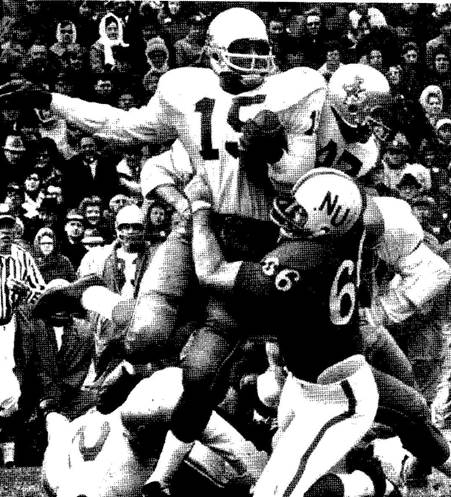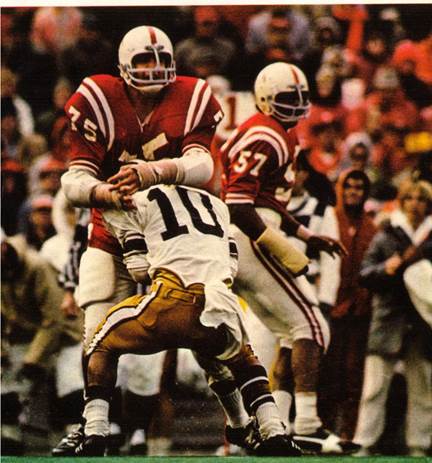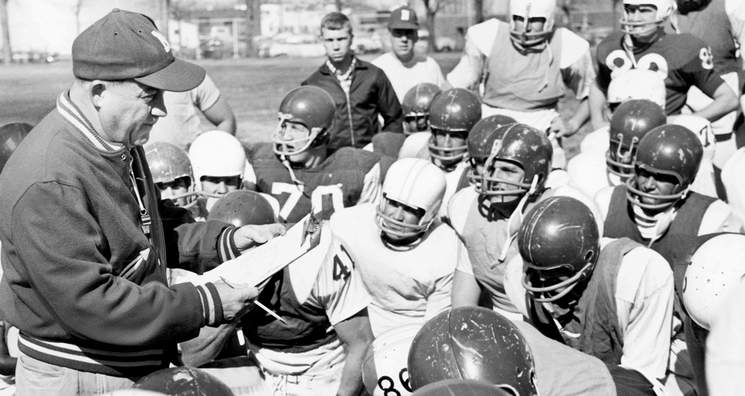

BOB DEVANEY AND HIS CORNHUSKERS, PART THREE
HELMET HUT NEWS/REFLECTIONS August 2015:
BOB DEVANEY AND HIS CORNHUSKERS, PART THREE
By Dr. Ken
While the consecutive 6-4
records of 1967 and 1968 would
have been a significant if not
tremendous improvement over
Nebraska’s typical football
fortunes of the years prior to
Bob Devaney’s ’62 arrival at
Lincoln, his success in the five
year period preceding this
two-year run of relative
mediocrity brought criticism. It
also served as a reminder of the
words spoken to John Melton, the
trusted assistant coach who had
followed Devaney from Wyoming to
Nebraska. As noted in Part One,
[ see
HELMET HUT
http://www.helmethut.com/Features/Dr.Ken140.html
] Melton was told by his Wyoming
banker that “You’re making a big
mistake those farmers will kill
you in Nebraska.” In retrospect,
the temporary dip in Devaney’s
incredible success attracted
what would have to be considered
unwarranted criticism but to the
head coach, this was part of a
long range strategy.
 |
Despite the 6-4 record, Nebraska had talent in 1967, including All American defensive lineman Wayne Meylan
Alabama had taken the Huskers to task in two consecutive bowl games and Devaney realized that he needed faster athletes, and hand-in-hand with that supposition was a second realization that his full house backfield needed diversification in order to take advantage of whatever speed he could inject into a new offensive formation. First however, Nebraska had to find and round up the necessary manpower. Assistant coach Jim Ross was brutally honest in talking about the two lean years that the Huskers suffered when he stated, “We just quit recruiting for a while” and Melton added the exclamation point to the situation with “The players weren’t playing very well and we weren’t doing a good job coaching.”
While team speed was an
emphasis, the defense had
been stout in the two down
seasons. Offensive
production had fallen off
however, with the Huskers
averaging 404 total yards
per game in 1965 and 279 in
’68. Points scored per game
also took a header, dropping
from thirty-five per contest
in 1965 to less than
thirteen in ’67. Hastings
College standout Tom Osborne
had joined Devaney’s staff
after a year with the
Redskins and another with
the Forty Niners, an
unheralded and little-used
receiver who saw his future
in coaching rather than in
continuing his playing
career. Completing graduate
work at Nebraska, Osborne
served as an unpaid
offensive assistant,
compensated with meals at
the training table and a
passel of tee shirts and
shorts. His role increased
as a full staff member and
he was named as offensive
coordinator in 1969, more or
less putting the finishing
touch on Devaney’s image for
his new approach. Osborne
installed an I-Formation
with a wide-spread wingback,
and often moved the
receivers in a manner that
foreshadowed the later
development of the modern
Spread Offenses. The 1968
recruiting class was
highlighted by quarterbacks
Jerry Tagge and Van Brownson,
both who were mobile and
with potent arms. Halfbacks
Jeff Kinney and Joe Orduna
featured a “Thunder And
Lightning” scenario but both
had breakaway speed. In
general, the smaller and
lighter recruits, a
departure for the Huskers,
provided what the coaches
sought. The defense too
emphasized quicker athletes
among the ’68 recruits, led
by Rich Glover, Willie
Harper, Bob Terrio, and
Larry Jacobson.
 |
Many fans did not see much difference or improvement from the 1967 and ’68 seasons as ’69 began sluggishly with a 31-21 loss to USC in the opener and a conference loss to Missouri after defeating mediocre Texas A&M and Minnesota squads. Devaney knew that both USC and Missouri were loaded and both were bowl teams at the end of the season. He knew too that his brand new offense needed a break-in period with innovative inside reverses, isolation blocking, and the infusion of his young speedsters. Quarterbacks Tagge and Brownson delivered as hoped for, proving to be apt rushers with mobility and able to pass when needed. While the fans were murmuring, the players and staff were confident that they had an excellent formula for success. Winning seven in a row proved that their optimism was warranted and the Kansas victory in the season’s fifth game kick-started a streak of thirty-two consecutive games without a loss. There was almost a 100 yard per game increase in total offensive production and a reversal of what had been a negative turnover margin.
The Huskers 9-2 record was completed with a huge win over Oklahoma and a 45-6 beat-down of Georgia in the Sun Bowl, leaving them ranked at number eleven in the final polls. Devaney saw the potential for more and wanted it going into ’70.USC was again a nemesis as the 21-21 tie versus the Trojans in the season’s second game was the only blemish on a huge 11-0-1 National Championship season. The offense was in place entering the first skirmish but there were questions about a defense that had lost eight starters. The doubters were quieted as both sides of the squad were superb and they were barely challenged until the Oklahoma game which was won 28-21 in Lincoln. That victory left the Cornhuskers ranked at number three going into the Orange Bowl against SEC Champion and fifth ranked LSU. The game, played in the evening during prime time, was perhaps the best of the bowl season, with quarterback Tagge completing a late sixty-seven yard drive with his sneak into the end zone. The 17-12 victory moved the Associated Press to vote Nebraska as Number One and moved Devaney to state, “Even the Pope wouldn’t vote for Notre Dame as Number One.”
As a “Legend In The Making” Coach Devaney still downplayed his role and remained the salt of the earth individual that had first arrived at Nebraska. He obviously had found a winning formula, one that allowed him to surpass the rather significant accomplishments of his first few years in Lincoln and it was a testament to his willingness to bring fundamental changes to his football philosophy. There was no change in the way he handled and treated his players and they continued to play hard for him and each other. By the time the 1971 season concluded, the entire football world was looking at Nebraska as a new standard. In a season that saw the Cornhuskers play an “extra” game sanctioned by the NCAA in Hawaii and finish at 12-0, Big Eight Conference foes Oklahoma and Colorado also made national headlines. OU had but one loss in completing an 11-1 year and a 40-22 victory over Auburn in the Sugar Bowl. That loss was of course, to Nebraska. Colorado stunned everyone with their 10-2 finish, Astro-Bluebonnet Bowl win over Houston, and losses only to conference rivals Oklahoma and Nebraska. The Huskers got yet another shot at Alabama and when the smoke cleared with Bear Bryant and the Crimson Tide on the wrong side of a 38-6 defeat, the legendary Bear was moved to say, “The 1971 Nebraska team is the best college team I have seen.” With Nebraska’s final ranking as the best in the nation, followed by number two Oklahoma, and number three Colorado, the accomplishments of both the Big Eight and Nebraska in being the best in the Big Eight, could not have emphasized more strongly, just how good the Husker team was.
The Thanksgiving Day Oklahoma game more than any other caught the fancy of the nation as The Game Of The Century featured OU’s best-in-the-country offense faced off against Monty Kiffin’s best-in-the-country defense. Television ratings were shattered and no doubt many platefuls of turkey and stuffing were left to get cold as the game was every bit as good as its billing. Marred by but one penalty call, both teams pounded each other with OU’s Jack Mildren and Greg Pruitt, matching NU’s Johnny Rodgers’ seventy-two yard punt return touchdown and the inside plunges of Jeff Kinney. A fourth quarter drive led by Tagge was the difference in Nebraska’s 35-31 victory in a game that has been highlighted by books and documentaries about its various aspects. To this day, the ’71 Nebraska team is rated by many college football experts as “possibly,” “probably,” “definitely,” “arguably,” and “without a doubt” the best of all time. Devaney to his credit, never bought in to “the greatest of all time” hype but admitted that he believed that he had a “great team.” There were individual stars that included Rodgers, Kinney, Tagge, Glover, Jacobsen, Joe Blahak, and Bob Terrio with Tagge, Kinney, and Jacobsen all first round NFL draft choices.
1972 had not started
when Coach Devaney
announced his
intention to step
down after the
season and pass the
reins to offensive
coordinator Osborne.
Some believe that
making that
announcement hurt
the team and that
the 9-2-1 Big Eight
Championship team,
even with its rather
easy 40-6 win over
Notre Dame in the
Orange Bowl, could
have better competed
for another National
Championship.
Players later noted
that the chain of
command was a bit
murky in that final
Devaney season, but
assistant coach Jim
Walden, later the
head man at Iowa
State, recalled that
“Our biggest
challenge was not
being over
confident.” He noted
that the opening
game loss to UCLA
and a surprising
23-all tie versus
Iowa State very much
resulted from being
“not ready and (we)
did not play with
the intensity that
we were known for.”
Still, Bob Devaney
stepped into the
Athletic Director’s
position as a full
time endeavor
following the Orange
Bowl win, leaving
large shoes for
Osborne to fill and
a finale that saw
the team ranked at
number nine, and
Johnny Rodgers
awarded the Heisman
Trophy. That in the
course of his
lengthy career Tom
Osborne did in fact
fulfill the mission
to meet or surpass
Devaney’s legacy
speaks well of the
program these men
ran. Devaney had
approved the
installation of
college football’s
first truly
organized strength
training program
under the direction
of the first full
time strength coach
in fields event
competitor Boyd
Epley and the
program became a
national
institution. Devaney
left college
coaching with a
tremendous 130-36-7
mark with National
Championships in
both 1970 and ’71.
He remained as NU’s
Athletic Director
until 1993 and
earned entry to the
College Football
Hall Of Fame.
 |
If one man can be accorded the honor of having shaped the culture of a football program, altered the role the team played within the psyche of the entire state, and changed the national perception of the university, it is Bob Devaney, a man and a coach who perhaps is deserving of more recognition than he receives.